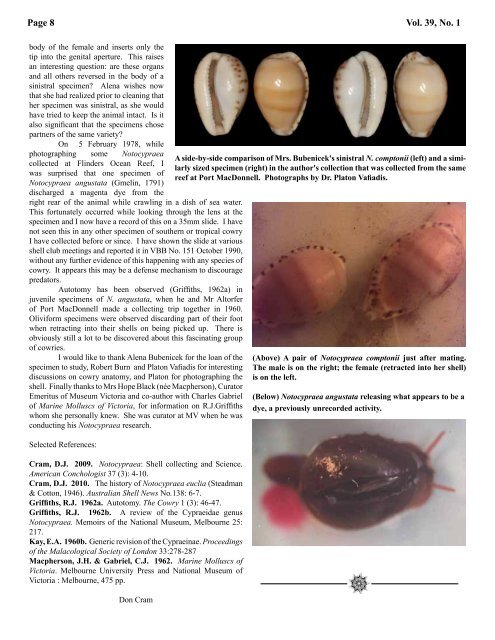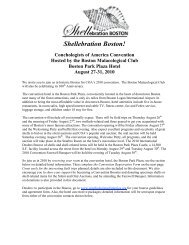download PDF - Conchologists of America
download PDF - Conchologists of America
download PDF - Conchologists of America
You also want an ePaper? Increase the reach of your titles
YUMPU automatically turns print PDFs into web optimized ePapers that Google loves.
Page 8 Vol. 39, No. 1<br />
body <strong>of</strong> the female and inserts only the<br />
tip into the genital aperture. This raises<br />
an interesting question: are these organs<br />
and all others reversed in the body <strong>of</strong> a<br />
sinistral specimen? Alena wishes now<br />
that she had realized prior to cleaning that<br />
her specimen was sinistral, as she would<br />
have tried to keep the animal intact. Is it<br />
also significant that the specimens chose<br />
partners <strong>of</strong> the same variety?<br />
On 5 February 1978, while<br />
photographing some Notocypraea<br />
collected at Flinders Ocean Reef, I<br />
was surprised that one specimen <strong>of</strong><br />
Notocypraea angustata (Gmelin, 1791)<br />
discharged a magenta dye from the<br />
right rear <strong>of</strong> the animal while crawling in a dish <strong>of</strong> sea water.<br />
This fortunately occurred while looking through the lens at the<br />
specimen and I now have a record <strong>of</strong> this on a 35mm slide. I have<br />
not seen this in any other specimen <strong>of</strong> southern or tropical cowry<br />
I have collected before or since. I have shown the slide at various<br />
shell club meetings and reported it in VBB No. 151 October 1990,<br />
without any further evidence <strong>of</strong> this happening with any species <strong>of</strong><br />
cowry. It appears this may be a defense mechanism to discourage<br />
predators.<br />
Autotomy has been observed (Griffiths, 1962a) in<br />
juvenile specimens <strong>of</strong> N. angustata, when he and Mr Altorfer<br />
<strong>of</strong> Port MacDonnell made a collecting trip together in 1960.<br />
Oliviform specimens were observed discarding part <strong>of</strong> their foot<br />
when retracting into their shells on being picked up. There is<br />
obviously still a lot to be discovered about this fascinating group<br />
<strong>of</strong> cowries.<br />
I would like to thank Alena Bubenicek for the loan <strong>of</strong> the<br />
specimen to study, Robert Burn and Platon Vafiadis for interesting<br />
discussions on cowry anatomy, and Platon for photographing the<br />
shell. Finally thanks to Mrs Hope Black (née Macpherson), Curator<br />
Emeritus <strong>of</strong> Museum Victoria and co-author with Charles Gabriel<br />
<strong>of</strong> Marine Molluscs <strong>of</strong> Victoria, for information on R.J.Griffiths<br />
whom she personally knew. She was curator at MV when he was<br />
conducting his Notocypraea research.<br />
Selected References:<br />
Cram, D.J. 2009. Notocypraea: Shell collecting and Science.<br />
<strong>America</strong>n Conchologist 37 (3): 4-10.<br />
Cram, D.J. 2010. The history <strong>of</strong> Notocypraea euclia (Steadman<br />
& Cotton, 1946). Australian Shell News No.138: 6-7.<br />
Griffiths, R.J. 1962a. Autotomy. The Cowry 1 (3): 46-47.<br />
Griffiths, R.J. 1962b. A review <strong>of</strong> the Cypraeidae genus<br />
Notocypraea. Memoirs <strong>of</strong> the National Museum, Melbourne 25:<br />
217.<br />
Kay, E.A. 1960b. Generic revision <strong>of</strong> the Cypraeinae. Proceedings<br />
<strong>of</strong> the Malacological Society <strong>of</strong> London 33:278-287<br />
Macpherson, J.H. & Gabriel, C.J. 1962. Marine Molluscs <strong>of</strong><br />
Victoria. Melbourne University Press and National Museum <strong>of</strong><br />
Victoria : Melbourne, 475 pp.<br />
Don Cram<br />
A side-by-side comparison <strong>of</strong> Mrs. Bubenicek's sinistral N. comptonii (left) and a similarly<br />
sized specimen (right) in the author's collection that was collected from the same<br />
reef at Port MacDonnell. Photographs by Dr. Platon Vafiadis.<br />
(Above) A pair <strong>of</strong> Notocypraea comptonii just after mating.<br />
The male is on the right; the female (retracted into her shell)<br />
is on the left.<br />
(Below) Notocypraea angustata releasing what appears to be a<br />
dye, a previously unrecorded activity.




